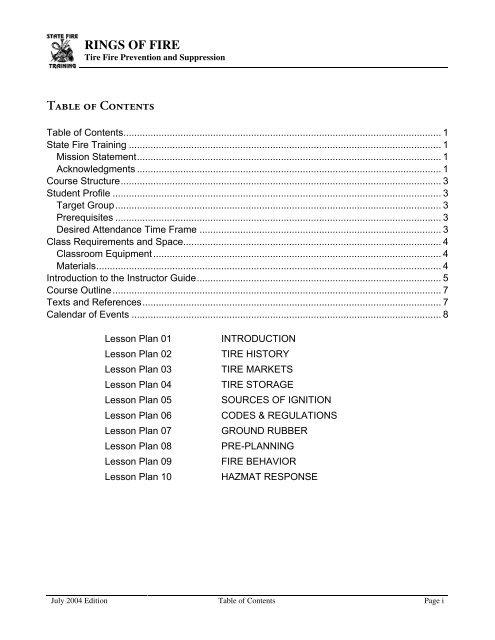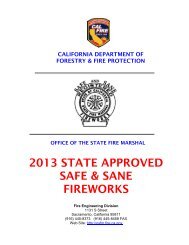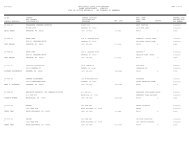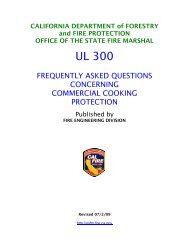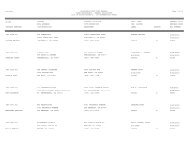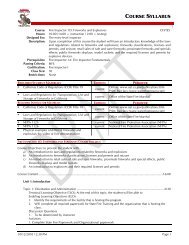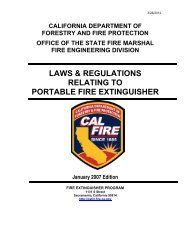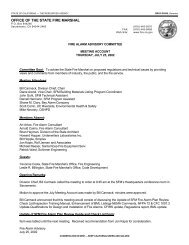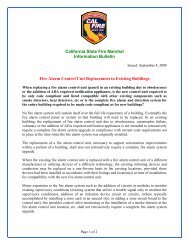RINGS OF FIRE Table of Contents - Office of the State Fire Marshal
RINGS OF FIRE Table of Contents - Office of the State Fire Marshal
RINGS OF FIRE Table of Contents - Office of the State Fire Marshal
Create successful ePaper yourself
Turn your PDF publications into a flip-book with our unique Google optimized e-Paper software.
<strong>RINGS</strong> <strong>OF</strong> <strong>FIRE</strong><br />
Tire <strong>Fire</strong> Prevention and Suppression<br />
<strong>Table</strong> <strong>of</strong> <strong>Contents</strong><br />
<strong>Table</strong> <strong>of</strong> <strong>Contents</strong>..................................................................................................................... 1<br />
<strong>State</strong> <strong>Fire</strong> Training ................................................................................................................... 1<br />
Mission <strong>State</strong>ment................................................................................................................ 1<br />
Acknowledgments ................................................................................................................ 1<br />
Course Structure...................................................................................................................... 3<br />
Student Pr<strong>of</strong>ile ......................................................................................................................... 3<br />
Target Group........................................................................................................................ 3<br />
Prerequisites ........................................................................................................................ 3<br />
Desired Attendance Time Frame ......................................................................................... 3<br />
Class Requirements and Space............................................................................................... 4<br />
Classroom Equipment .......................................................................................................... 4<br />
Materials............................................................................................................................... 4<br />
Introduction to <strong>the</strong> Instructor Guide.......................................................................................... 5<br />
Course Outline......................................................................................................................... 7<br />
Texts and References.............................................................................................................. 7<br />
Calendar <strong>of</strong> Events .................................................................................................................. 8<br />
Lesson Plan 01<br />
Lesson Plan 02<br />
Lesson Plan 03<br />
Lesson Plan 04<br />
Lesson Plan 05<br />
Lesson Plan 06<br />
Lesson Plan 07<br />
Lesson Plan 08<br />
Lesson Plan 09<br />
Lesson Plan 10<br />
INTRODUCTION<br />
TIRE HISTORY<br />
TIRE MARKETS<br />
TIRE STORAGE<br />
SOURCES <strong>OF</strong> IGNITION<br />
CODES & REGULATIONS<br />
GROUND RUBBER<br />
PRE-PLANNING<br />
<strong>FIRE</strong> BEHAVIOR<br />
HAZMAT RESPONSE<br />
July 2004 Edition <strong>Table</strong> <strong>of</strong> <strong>Contents</strong> Page i
<strong>RINGS</strong> <strong>OF</strong> <strong>FIRE</strong><br />
Tire <strong>Fire</strong> Prevention and Suppression<br />
<strong>State</strong> <strong>Fire</strong> Training<br />
Mission <strong>State</strong>ment<br />
The mission <strong>of</strong> <strong>State</strong> <strong>Fire</strong> Training is to enable <strong>the</strong> California fire service to safely protect life<br />
and property through education, training, and certification.<br />
Acknowledgments<br />
The Code Development and Analysis Division <strong>of</strong> <strong>the</strong> <strong>Office</strong> <strong>of</strong> <strong>the</strong> <strong>State</strong> <strong>Fire</strong> <strong>Marshal</strong><br />
developed <strong>the</strong> material contained in this guide.<br />
Dale Geldert<br />
Director <strong>of</strong> CDF<br />
RANDY ROXSON<br />
ASSISTANT DEPUTY CHIEF<br />
Ruben Grijalva<br />
<strong>State</strong> <strong>Fire</strong> <strong>Marshal</strong><br />
GINI KRIPPNER, DIVISION CHIEF<br />
CODE DEVELOPMENT AND ANALYSIS<br />
2004 August <strong>State</strong> <strong>Fire</strong> Training Page 1
<strong>RINGS</strong> <strong>OF</strong> <strong>FIRE</strong><br />
Tire <strong>Fire</strong> Prevention and Suppression<br />
The material contained in this document was compiled and organized through <strong>the</strong><br />
cooperative effort <strong>of</strong> numerous pr<strong>of</strong>essionals within, and associated with, <strong>the</strong> California fire<br />
service. We gratefully acknowledge <strong>the</strong>se individuals who served as principal developers for<br />
this document.<br />
Rodney Slaughter, Program Coordinator<br />
<strong>Office</strong> <strong>of</strong> <strong>the</strong> <strong>State</strong> <strong>Fire</strong> <strong>Marshal</strong><br />
Todd Thalhammer, Contract Manager<br />
California Integrated Waste<br />
Management Board<br />
Michael Blummenthal,<br />
Rubber Manufacturers Association<br />
Kent Miller, Stockton <strong>Fire</strong> Department<br />
Robert Gill, Central Calaveras<br />
<strong>Fire</strong> & Rescue<br />
Terry Welsh, San Bernardino County<br />
<strong>Fire</strong> Department<br />
James Weigand, Stanislaus Consolidated<br />
<strong>Fire</strong> Department<br />
Tom Horton, Sacramento Metro<br />
<strong>Fire</strong> Department<br />
Rich Johnson, North County <strong>Fire</strong> Authority<br />
Darrin DeCarli, Sonoma County<br />
Department <strong>of</strong> Emergency Services<br />
“We gratefully acknowledge <strong>the</strong> hard work and accomplishments <strong>of</strong> those before us who<br />
built <strong>the</strong> solid foundation on which this program continues to grow.”<br />
2004 August <strong>State</strong> <strong>Fire</strong> Training Page 2
<strong>RINGS</strong> <strong>OF</strong> <strong>FIRE</strong><br />
Tire <strong>Fire</strong> Prevention and Suppression<br />
Course Structure<br />
This class is a revision and update <strong>of</strong> <strong>the</strong> original “Rings <strong>of</strong> <strong>Fire</strong>” training program produced<br />
by <strong>the</strong> Training Division <strong>of</strong> <strong>the</strong> <strong>State</strong> <strong>Fire</strong> <strong>Marshal</strong>’s <strong>Office</strong>. The rewrite <strong>of</strong> this class was made<br />
possible by a report entitled, “Tire Pile <strong>Fire</strong>s; Prevention, Response, Remediation,<br />
Environmental Engineering and Contracting” September 23, 2002, commissioned by <strong>the</strong><br />
California Integrated Waste Management Board. This base document was dissected by <strong>the</strong><br />
California Tire <strong>Fire</strong> Council, a group <strong>of</strong> fire prevention and training <strong>of</strong>ficers, hazmat experts,<br />
and scrap tire industry spokespersons for appropriate content to be delivered to first<br />
responders, local enforcement agencies and tire dealers and operators.<br />
This program is designed as an 8-hour class. It can be customized to accommodate one or two-hour<br />
crew training, or you can use this curriculum in conjunction with o<strong>the</strong>r hazardous material or fire code<br />
training programs. The opened-ended design <strong>of</strong> <strong>the</strong> course materials purposely allows <strong>the</strong> instructor a<br />
great deal <strong>of</strong> flexibility and course delivery options.<br />
Student Pr<strong>of</strong>ile<br />
Target Group<br />
First responders, local enforcement agencies, scrap tire dealers, owners and operators.<br />
Prerequisites<br />
None<br />
Desired Attendance Time Frame<br />
None<br />
2004 August Course Structure Page 3
<strong>RINGS</strong> <strong>OF</strong> <strong>FIRE</strong><br />
Tire <strong>Fire</strong> Prevention and Suppression<br />
Class Requirements and Space<br />
The characteristics <strong>of</strong> <strong>the</strong> classroom and support facilities have a great impact on <strong>the</strong> learning<br />
environment and <strong>the</strong> instructor’s success or failure. For this course, it is advisable for <strong>the</strong><br />
instructor to adhere as closely as possible to <strong>the</strong> following guidelines.<br />
Classroom Equipment<br />
Writing board with markers/erasers<br />
PC projector<br />
Projection screen<br />
VCR or DVD player<br />
Audio System (Speakers and Amplifier)<br />
Materials<br />
“Rings <strong>of</strong> <strong>Fire</strong>” Instructor Guide<br />
“Rings <strong>of</strong> <strong>Fire</strong>” Video (VHS or DVD)<br />
“Rings <strong>of</strong> <strong>Fire</strong>” Student Text<br />
“Rings <strong>of</strong> <strong>Fire</strong>” Student Handout<br />
Multimedia slide show on CD/ROM<br />
2004 August Class Requirements and Space Page 4
<strong>RINGS</strong> <strong>OF</strong> <strong>FIRE</strong><br />
Tire <strong>Fire</strong> Prevention and Suppression<br />
Introduction to <strong>the</strong> Instructor Guide<br />
This publication is intended to serve as an instructor guide and includes lesson plans, a slide<br />
index, student activities, and tests. For each topic identified in <strong>the</strong> course outline, a lesson plan<br />
has been developed that contains: a time frame, level <strong>of</strong> instruction, behavioral objective,<br />
materials needed, references, preparation statement, lesson content, and endnotes. Suggested<br />
application methods have been identified throughout <strong>the</strong> lessons for you to use during your<br />
presentation.<br />
• Time Frame: The estimated duration required for in-class presentation.<br />
• Level <strong>of</strong> Instruction: Identifies <strong>the</strong> instructional level that <strong>the</strong> material was designed to<br />
fulfill. Obviously, you have <strong>the</strong> latitude to increase <strong>the</strong> level based on available time, local<br />
conditions, and <strong>the</strong> students' apperceptive base.<br />
• Behavioral Objective: The behavioral objective is a statement <strong>of</strong> <strong>the</strong> student's<br />
performance desired at <strong>the</strong> end <strong>of</strong> instruction. You must ensure that enough information is<br />
given in <strong>the</strong> presentation and/or activities to enable <strong>the</strong> student to perform according to<br />
<strong>the</strong> goal.<br />
• Materials Needed: This should be a complete list <strong>of</strong> everything you will need to present<br />
<strong>the</strong> lesson, including visual aids, tests, and so on.<br />
• References: These are <strong>the</strong> specific references <strong>the</strong> curriculum development team used<br />
when developing <strong>the</strong> lesson plan. In addition, references may be listed as additional study<br />
aids for instructors to enhance <strong>the</strong> lesson -- books, manuals, bulletins, scripts, visual aid<br />
utilization plans and <strong>the</strong> like. The corresponding pages in <strong>the</strong> student supplement are also<br />
listed here.<br />
• Preparation: The motivational statements in this section connect <strong>the</strong> student with <strong>the</strong><br />
lesson plan topic through examples or illustrations relating to <strong>the</strong>ir occupation, injury, and<br />
even mortality. You may modify this section to better fit your students' environment.<br />
• Lesson Content: Includes information used in <strong>the</strong> four-step method <strong>of</strong> instruction.<br />
Technical Lesson Plans<br />
Presentation<br />
Everything you say or display<br />
Content<br />
Notes<br />
Application<br />
Everything <strong>the</strong> student<br />
participates in<br />
Questions<br />
Activities<br />
Audiovisual Cues<br />
MULTIMEDIA PRESENTATION<br />
2004 August Introduction to <strong>the</strong> Instructor Guide Page 5
<strong>RINGS</strong> <strong>OF</strong> <strong>FIRE</strong><br />
Tire <strong>Fire</strong> Prevention and Suppression<br />
The multimedia presentation was developed in a program called “Astound.” You do not need <strong>the</strong><br />
s<strong>of</strong>tware or license to run this program. It is suggested that you transfer by clicking and dragging <strong>the</strong><br />
presentation file from <strong>the</strong> CD/ROM to a file on your hard drive. While <strong>the</strong> program will run from <strong>the</strong><br />
CD, it runs even better <strong>of</strong>f <strong>of</strong> your hard drive.<br />
The presentation and your lesson plans are set-up to allow you to customize <strong>the</strong> delivery <strong>of</strong> this<br />
program into short subject courses for one or two-hour crew training or as an eight-hour stand-alone<br />
class. To enable this function, a menu slide was added for your convenience to navigate specific<br />
subject areas.<br />
When you get to <strong>the</strong> end <strong>of</strong> <strong>the</strong> lesson <strong>the</strong> slide will automatically advance back to <strong>the</strong> menu slide. To<br />
advance <strong>the</strong> slides click on <strong>the</strong> left mouse button. You can also use your left and right arrow keys to<br />
advance or go back to a previous slide. To go to ano<strong>the</strong>r section <strong>of</strong> <strong>the</strong> program click and hold your<br />
right mouse button and release. A small window displaying all <strong>of</strong> <strong>the</strong> slides will appear. To exit this<br />
program at any time simply hit <strong>the</strong> escape key on your computer or you can use <strong>the</strong> exit button on <strong>the</strong><br />
“Main Menu.”<br />
There are several unique pens available on your presentation. To change pen color and function use <strong>the</strong><br />
following key code:<br />
F2 Black Pen— handy for circling or to use to check bulleted items.<br />
F3 Red Pen—handy for slides with a dark background to highlight certain information.<br />
F4 Yellow Highlighter—used like a regular highlighter and not obscure <strong>the</strong> text.<br />
F5 Pink Highlighter—provides you an option with <strong>the</strong> yellow highlighter.<br />
To make <strong>the</strong> pens work, click and hold you left mouse button, and while its held down move <strong>the</strong><br />
mouse across <strong>the</strong> slide. Experiment and practice with <strong>the</strong>se pens to customize <strong>the</strong> delivery <strong>of</strong> your<br />
presentation.<br />
2004 August Introduction to <strong>the</strong> Instructor Guide Page 6
<strong>RINGS</strong> <strong>OF</strong> <strong>FIRE</strong><br />
Tire <strong>Fire</strong> Prevention and Suppression<br />
Course Outline<br />
Course Objectives: To provide <strong>the</strong> student with…<br />
a) Background and history <strong>of</strong> scrap tire industry<br />
b) Chemical compounds in tire manufacturing<br />
c) Traditional sources <strong>of</strong> ignition<br />
d) Current codes and regulations<br />
e) Ground rubber operations and hazards<br />
f) Pre-fire planning <strong>of</strong> outdoor tire storage yards<br />
g) Tire fire behavior<br />
h) Hazardous Materials Response<br />
Course Content........................................................................................................................<br />
Introduction – Defining <strong>the</strong> Problem ...............................................................................0:30<br />
Tire History........................................................................................................................0:30<br />
Tire Markets.......................................................................................................................0:30<br />
Tire Storage.......................................................................................................................0:30<br />
Sources <strong>of</strong> Ignition ...........................................................................................................0:30<br />
Codes and Regulations ....................................................................................................1:00<br />
Ground Rubber .................................................................................................................0:30<br />
Preplanning .......................................................................................................................0:30<br />
<strong>Fire</strong> Behavior.....................................................................................................................0:30<br />
Hazmat Response .............................................................................................................1:00<br />
Texts and References<br />
• Slaughter, Rodney, “<strong>RINGS</strong> <strong>OF</strong> <strong>FIRE</strong>: Tire <strong>Fire</strong> Prevention and Suppression” California<br />
<strong>State</strong> <strong>Fire</strong> <strong>Marshal</strong>, June 2004.<br />
2004 August Course Outline Page 7
<strong>RINGS</strong> <strong>OF</strong> <strong>FIRE</strong><br />
Tire <strong>Fire</strong> Prevention and Suppression<br />
Calendar <strong>of</strong> Events<br />
DAY TOPIC TITLE TIME ACTIVITY EVALUATION<br />
1 Introduction – Defining <strong>the</strong> Problem 0:30 Lecture<br />
2 Tire History 0:30 Lecture<br />
3 Tire Markets 0:30 Lecture<br />
4 Tire Storage 0:30 Lecture<br />
5 Sources <strong>of</strong> Ignition 0:30 Lecture<br />
6 Codes & Regulations 1:00 Lecture<br />
Day 1<br />
Lunch 1:00<br />
7 Ground Rubber 0:30 Lecture<br />
Test<br />
8 Preplanning 0:30 Lecture<br />
9 <strong>Fire</strong> Behavior 0:30 Lecture<br />
10 Hazmat Response 1:00 Lecture<br />
Day 1 Total 7:00<br />
2004 August Calendar <strong>of</strong> Events Page 8
<strong>RINGS</strong> <strong>OF</strong> <strong>FIRE</strong><br />
Tire <strong>Fire</strong> Prevention and Suppression<br />
INSTRUCTOR EVALUATION<br />
To pass this class, and get an FSTEP certificate, students need to score 70%. In o<strong>the</strong>r<br />
words, students can only miss 6 out <strong>of</strong> <strong>the</strong> 20 questions on this evaluation.<br />
1. California generates approximately 10% <strong>of</strong> all <strong>the</strong> scrap tires in <strong>the</strong> country.<br />
True- California generates over 30 million and 300 million are generated annually in<br />
<strong>the</strong> U.S.<br />
2. Carbon was added to <strong>the</strong> tires chemistry, so if a tire does catch on fire it will burn<br />
cleaner and faster.<br />
False- Carbon was added to reduce wear.<br />
3. The pyrolytic oil generated from a tire fire is no more hazardous than crankcase oil.<br />
False- Pyrolytic oil has a higher concentration <strong>of</strong> harmful chemicals.<br />
4. The largest market for scrap tires in California is in <strong>the</strong> production <strong>of</strong> ground rubber.<br />
True- California uses 15 million tires in <strong>the</strong> production <strong>of</strong> crumb or ground rubber.<br />
5. The amount <strong>of</strong> heat released by one pound <strong>of</strong> tire material is 7,400 BTU or 17,242<br />
kilojoules per kilogram.<br />
False- one pond <strong>of</strong> tire material generates 15,000 btu per pound or 34,950 kilojoules<br />
per kilogram.<br />
6. Outdoor tire storage is typically randomly stacked regardless <strong>of</strong> code application.<br />
True- Randomly stacked tires take less effort than o<strong>the</strong>r storage methods.<br />
7. Wildland fires are <strong>the</strong> leading cause <strong>of</strong> tire pile ignitions.<br />
False- Historically, arson is <strong>the</strong> leading cause <strong>of</strong> tire fires.<br />
8. Local fire departments cannot enforce CIWMB regulations unless adopted locally.<br />
2004 August Calendar <strong>of</strong> Events Page 9
<strong>RINGS</strong> <strong>OF</strong> <strong>FIRE</strong><br />
Tire <strong>Fire</strong> Prevention and Suppression<br />
True- Local fire departments can however use national recognized standards<br />
according to Title 19.<br />
9. Having o<strong>the</strong>r agencies participate in local enforcement is a good idea.<br />
True- A Unified Enforcement program produces better results.<br />
10. The 2002 edition <strong>of</strong> NFPA 230 Annex F, provides a complete standard for outdoor tire<br />
storage.<br />
True- NFPA is more complete than <strong>the</strong> current Uniform <strong>Fire</strong> Code which only restricts<br />
tire pile size.<br />
11. Tire piles <strong>of</strong> 5,000 or less do not need a permit from <strong>the</strong> CIWMB.<br />
False- Tire piles <strong>of</strong> 500 to 5,000 require a minor waste tire permit from CIWMB.<br />
12. The best way to reduce outdoor tire storage (and avoid regulation) is to lease an<br />
empty unsprinklered warehouse and store <strong>the</strong> tires indoors.<br />
False- Unscrupulous operators do this to avoid detection and regulation.<br />
13. Processing operations that produce crumb or ground rubber have a high incidence <strong>of</strong><br />
fires.<br />
True- from retreading operations to ground rubber facilities, tire fires are common.<br />
14. Large piles <strong>of</strong> tires can be found in automotive salvage yards, solid waste facilites,<br />
property dedicated to tire storage, retreading shops, agricultural areas, and ground<br />
rubber facilities.<br />
True- Stock piles <strong>of</strong> tires can be found in a wide range <strong>of</strong> places.<br />
15. The pre-fire plan should include contact info for state and federal agencies.<br />
True- <strong>State</strong> and federal agencies can order up <strong>the</strong> resources you will need to combat<br />
this emergency.<br />
16 The best way to fight a fully involved tire fire is to protect exposures until <strong>the</strong> pile is in<br />
<strong>the</strong> smoldering phase and <strong>the</strong>n using heavy equipment pull <strong>the</strong> tire pile apart and<br />
extinguish incrementally.<br />
2004 August Calendar <strong>of</strong> Events Page 10
<strong>RINGS</strong> <strong>OF</strong> <strong>FIRE</strong><br />
Tire <strong>Fire</strong> Prevention and Suppression<br />
True- O<strong>the</strong>r methods will endanger personnel or exacerbate <strong>the</strong> impact ot <strong>the</strong><br />
environment.<br />
17. Suppliers <strong>of</strong> foam products specifically designed for tire fires should be identified, and<br />
<strong>the</strong> amount needed, in your pre-fire plan.<br />
False- Foam has not proven to be any better than water on tire fires, with <strong>the</strong><br />
exception <strong>of</strong> small tire fires <strong>of</strong> 500 or less.<br />
18. Tire fires are not a hazardous materials response.<br />
False- The products <strong>of</strong> combustion have a very high health hazard concern for those<br />
operating in and around <strong>the</strong> tire fire.<br />
19. Ground or crumb rubber piles have lower flame lengths and can be extinguished with<br />
water applied in a fog pattern.<br />
True- altered tire material has lower flame lengths and is easier to extinguish.<br />
20. Covering a tire pile fire with earth is <strong>the</strong> fastest way to extinguish a tire fire.<br />
False- burying a tire fire allows it to continue to burn creating more pyrolytic oil and<br />
larger environmental impact.<br />
2004 August Calendar <strong>of</strong> Events Page 11
<strong>RINGS</strong> <strong>OF</strong> <strong>FIRE</strong><br />
Tire <strong>Fire</strong> Prevention and Suppression<br />
Student Evaluation<br />
Read each statement and circle ei<strong>the</strong>r true or false<br />
if you agree or disagree with <strong>the</strong> statement.<br />
1. California generates approximately 10% <strong>of</strong> all <strong>the</strong> scrap tires in <strong>the</strong> country.<br />
True - False<br />
2. Carbon was added to <strong>the</strong> tires chemistry, so if a tire does catch on fire it will burn<br />
cleaner and faster.<br />
True - False<br />
3. The pyrolytic oil generated from a tire fire is no more hazardous than crankcase oil.<br />
True – False<br />
4. The largest market for scrap tires in California is in <strong>the</strong> production <strong>of</strong> ground rubber.<br />
True – False<br />
5. The amount <strong>of</strong> heat released by one pound <strong>of</strong> tire material is 7,400 BTU or 17,242<br />
kilojoules per kilogram.<br />
True – False<br />
6. Outdoor tire storage is typically randomly stacked regardless <strong>of</strong> code application.<br />
True – False<br />
7. Wildland fires are <strong>the</strong> leading cause <strong>of</strong> tire pile ignitions.<br />
True - False<br />
8. Local fire departments cannot enforce CIWMB regulations unless adopted locally.<br />
True - False<br />
9. Having o<strong>the</strong>r agencies participate in local enforcement is a good idea.<br />
True – False<br />
2004 August Calendar <strong>of</strong> Events Page 12
<strong>RINGS</strong> <strong>OF</strong> <strong>FIRE</strong><br />
Tire <strong>Fire</strong> Prevention and Suppression<br />
10. The 2002 edition <strong>of</strong> NFPA 230 Annex F, provides a complete standard for outdoor tire<br />
storage.<br />
True – False<br />
11. Tire piles <strong>of</strong> 5,000 or less do not need a permit from <strong>the</strong> CIWMB.<br />
True - False<br />
12. The best way to reduce outdoor tire storage (and avoid regulation) is to lease an<br />
empty unsprinklered warehouse and store <strong>the</strong> tires indoors.<br />
True – False<br />
13. Processing operations that produce crumb or ground rubber have a high incidence <strong>of</strong><br />
fires.<br />
True - False<br />
14. Large piles <strong>of</strong> tires can be found in automotive salvage yards, solid waste facilites,<br />
property dedicated to tire storage, retreading shops, agricultural areas, and ground<br />
rubber facilities.<br />
True – False<br />
15. The pre-fire plan should include contact info for state and federal agencies.<br />
True – False<br />
16 The best way to fight a fully involved tire fire is to protect exposures until <strong>the</strong> pile is in<br />
<strong>the</strong> smoldering phase and <strong>the</strong>n using heavy equipment pull <strong>the</strong> tire pile apart and<br />
extinguish incrementally.<br />
True – False<br />
17. Suppliers <strong>of</strong> foam products specifically designed for tire fires should be identified, and<br />
<strong>the</strong> amount needed, in your pre-fire plan.<br />
True - False<br />
18. Tire fires are not a hazardous materials response.<br />
2004 August Calendar <strong>of</strong> Events Page 13
<strong>RINGS</strong> <strong>OF</strong> <strong>FIRE</strong><br />
Tire <strong>Fire</strong> Prevention and Suppression<br />
True – False<br />
19. Ground or crumb rubber piles have lower flame lengths and can be extinguished with<br />
water applied in a fog pattern.<br />
True – False<br />
20. Covering a tire pile fire with earth is <strong>the</strong> fastest way to extinguish a tire fire.<br />
True - False<br />
2004 August Calendar <strong>of</strong> Events Page 14


